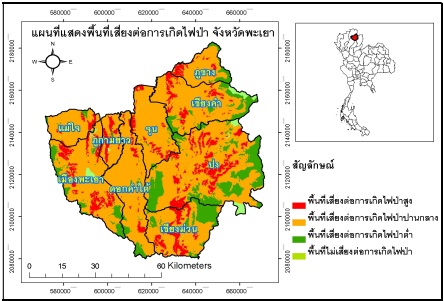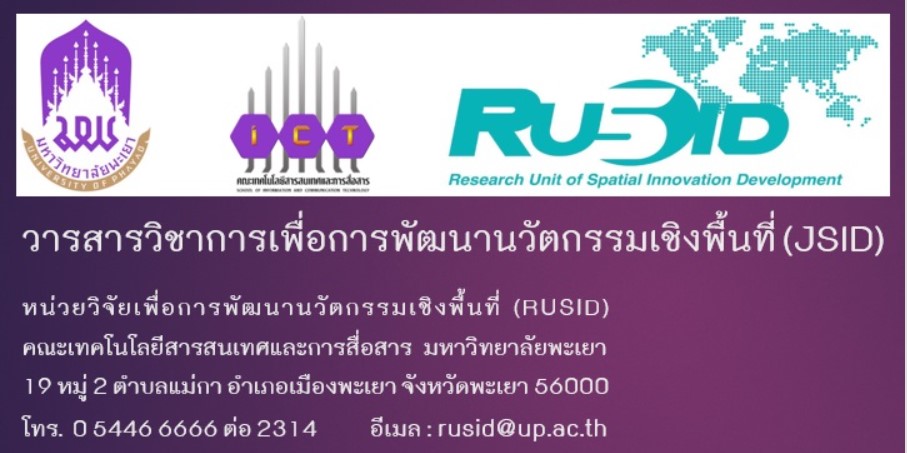การประเมินพื้นที่เสี่ยงต่อการเกิดไฟป่าด้วยกระบวนการลำดับชั้นเชิงวิเคราะห์พื้นที่จังหวัดพะเยา
คำสำคัญ:
ไฟป่า, ระบบสารสนเทศภูมิศาสตร์, แบบจำลองกระบวนการลำดับชั้นเชิงวิเคราะห์, จังหวัดพะเยาบทคัดย่อ
ภาคเหนือมีการเกิดไฟป่ามากกว่าทุกภาค อัตราการเกิดไฟป่าเฉลี่ยประมาณ 1,167 ครั้งต่อปี จังหวัดพะเยามีสภาพอากาศร้อน ทำให้สภาพป่ามีความแห้งแล้งอีกทั้งง่ายต่อการเกิดไฟป่า โดยเฉพาะช่วงเดือนกุมภาพันธ์ถึงเดือนเมษายนเป็นเดือนที่มีความเสี่ยงต่อไฟป่ามากที่สุด การศึกษาวิจัยในครั้งนี้มีวัตถุประสงค์หลักเพื่อประเมินพื้นที่เสี่ยงต่อการเกิดไฟป่าในพื้นที่จังหวัดพะเยา วิธีการดำเนินงานได้ใช้แบบสัมภาษณ์ผู้เชี่ยวชาญเป็นผู้ให้ค่าคะแนนน้ำหนักปัจจัยที่เกี่ยวข้องจำนวน 8 ปัจจัย ได้แก่ การใช้ประโยชน์ที่ดิน ประเภทป่าไม้ ระยะห่างจากเส้นทางคมนาคม ระยะห่างจากเส้นทางน้ำ ระยะห่างจากตำแหน่งหมู่บ้าน ระยะห่างจากพื้นที่เกษตรกรรม ความลาดชัน และความสูง และนำมาวิเคราะห์ด้วยแบบจำลองกระบวนการลำดับชั้นเชิงวิเคราะห์ โดยแบ่งระดับความเสี่ยงออกเป็น 4 ระดับ ได้แก่ ระดับสูง ระดับปานกลาง ระดับต่ำ และไม่เสี่ยงต่อการเกิดไฟป่า ผลการศึกษาพบว่าพื้นที่เสี่ยงต่อการเกิดไฟป่าระดับปานกลางจำนวน 4,553.11 ตร.กม. คิดเป็นร้อยละ 71.87 พื้นที่เสี่ยงต่อการเกิดไฟป่าระดับต่ำจำนวน 939.64 ตร.กม. คิดเป็นร้อยละ 14.83 พื้นที่เสี่ยงต่อการเกิดไฟป่าระดับสูงมีจำนวน 796.25 ตร.กม. คิดเป็นร้อยละ 12.57 และพื้นที่ไม่เสี่ยงต่อการเกิดไฟป่า 46.21 ตร.กม. คิดเป็นร้อยละ 0.73 สำหรับอำเภอที่มีความเสี่ยงต่อการเกิดไฟป่าระดับสูงที่สุด คือภูกามยาว รองลงมาคือเชียงม่วน ดังนั้นหน่วยงานที่เกี่ยวข้องหรือเจ้าหน้าที่ด้านการบรรเทาและป้องกันสาธารณภัยสามารถนำผลการศึกษาไปเป็นแนวทางในการรับมือไฟป่าในอนาคตได้
เอกสารอ้างอิง
Rotjanakusol, T. & Laosuwan, T. (2018). Inundation area investigation approach using remote sensing technology on 2017 flooding in Sakon Nakhon province Thailand”. Studia Universitatis Vasile Goldis Arad, Seria Stiintele Vietii, 28(4), 159-166.
Milly, P.C., Wetherald, R.T., Dunne, K.A., & Delworth, T.L. (2002). Increasing Risk of Great Floods in a Changing Climate. Nature. 15(6871), 514-517.
ไพศาล จี้ฟู (2561). การพัฒนาโปรแกรมประยุกต์สำหรับระบบสารสนเทศภูมิศาสตร์บนเว็บ (Application Development for Web-based GIS), พิมพ์ครั้งที่ 1 จำนวน 500 เล่ม, สำนักพิมพ์จุฬาลงกรณ์มหาวิทยาลัย, ISBN : 9789740337508.
สัญญา สราภิรมย์. (2549). เอกสารประกอบการสอนวิชาระบบสารสนเทศภูมิศาสตร์ (106611). นครราชสีมา: สาขาการรับรู้ระยะไกล สำนักวิชาวิทยาศาสตร์ มหาวิทยาลัยเทคโนโลยีสุรนารี
จรรยา บุญสอน. (2560). การวิเคราะห์พื้นที่เสี่ยงน้ำท่วมฉับพลัน : กรณีศึกษาห้วยแม่ท่าแพ อ.ศรีสัชนาลัย จ.สุโขทัย. วิทยานิพนธ์ระดับปริญญาตรี ภาควิชาทรัพยากรธรรมชาติและสิ่งแวดล้อม คณะเกษตรศาสตร์ ทรัพยากรธรรมชาติและสิ่งแวดล้อม มหาวิทยาลัยนเรศวร.
Fundamental Geographic Data Set (FGDS). (2556). Retrieved from www.ngis.go.th/home/wp-content/uploads/2019/03/FundamentalGeographicDataSet_FGDS.pdf (in Thai)
Saaty, T.L. (1980). The analytical hierarchy process”, New York: McGraw-Hill.
Pawattana, C., and Tripathi, N.K. (2008). Analytical Hierarchy Process (AHP) – Based Flood Water Retention Planning in Thailand. GIScience and Remote Sensing, 45, 343-355.
Tseng, C.C., Hong, C.F., and Chamg, H.L. (2008). Multiple Attribute Decision-Making Model for Medical Service Selection: an AHP approach. Journal of Quality, 15, 155-165.
Jeefoo, P., and Tripathi, N.K. (2011). Dengue Risk Zone Index (DRZI) for Mapping Dengue Risk Areas. International Journal of Geoinformatics, 7(1), 53-62.
Thirumalaivasan, D., Karmegam, M., and Venugopal, K. (2003). AHP-DRASTIC: Software for Specific Aquifer Vulnerability Assessment using DRASTIC model and GIS. Environmental Modelling and Software. 18, 645-656.





